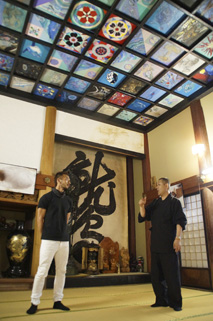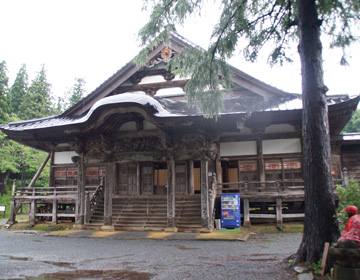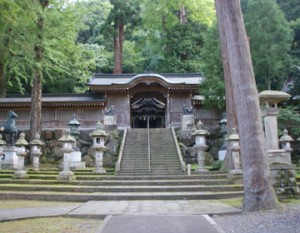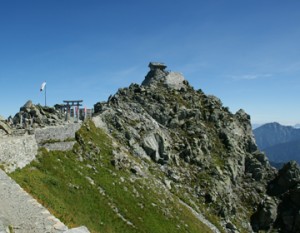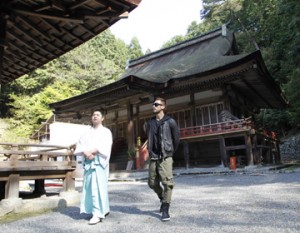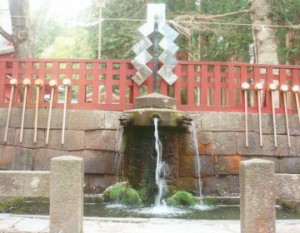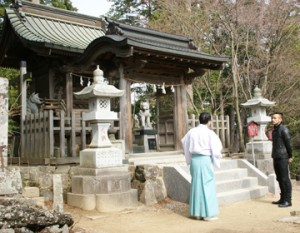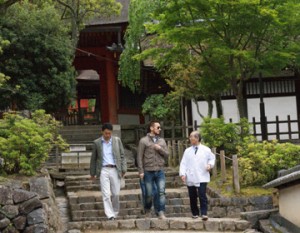About Churenji
Mount Haguro-san, Yudono-san, and Gassan, known collectively as the three Dewa mountains, are the three most powerful spiritual spots of the Tohoku region since the ancient ages. This day we visited ”Yudono-san Churenji” in Tsuruoka, Yamagata Prefecture. In the era of ”Shinbutsu Shugo” or the syncretistic fusion of Buddhism and Shintoism, many temples were built here, and groups of ”shugendo” mountain asceticists were generated in this area. Churenji is is said to have been opened by the famous Buddhist monk Kobo Daishi in 883AD and enshrines the Dainichi Nyorai (Mahāvairocana) . The temple belongs to the Yudono-san sect. We met with Hiroaki Sato, the chief priest of the temple, who lectured us on the role Churenji played in the religious ceremonies.
”One of the things mountain ascetics wear when they go into the mountains, is a rope hanging from their neck. This is called a ”Churen-nawa”, which is basically the same as the ”shimenawa” that most of you know.
The three Dewa mountains are where many spirits are believed to reside, so the ”shimenawa” is worn to keep them off, for protection. Churenji is placed here to be the ”shimenawa”, the barrier for the domain to separate Yudono-san from the secular world. Churenji is located on Shime Kakeguchi, one of the approach ways to Yudono-san.
With the coming of the Meiji era, reflecting the movement for the separation of Shintoism from Buddhism, many temples in the three Dewa Mountains were abolished. Churenji escaped that fate, but there was a period when their status declined . With the coming of the Showa era, it became widely known to the public as the stage for the novel ”Gassan”.
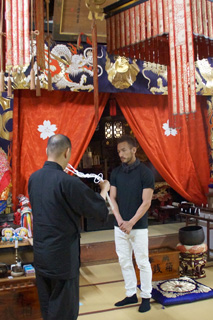
Egan-in tetsumonkai Shounin、the Living Buddha
During the Edo era, there was a monk who contributed to the fame of Churenji, a man of many legends. His name was Egan-in Tetsumonkai Shounin, who became a ”living Buddha” as a result of his ascetic practices. His body can be seen in the miniature shrine within the temple and can be seen by visitors. A ”living Buddha” is the mummified body of a monk who went on with his ascetic practices to his physical death. Also called the ”mummy buddha”, 8 of these bodies remain in Yamagata Prefecture, with the body of Egain-in Tetsumonkai Shounin in Churenji is among the eight.
Egan-in Tetsumonkai Shounin、became a ”living Buddha after 3000 days of ascetic practices. He is said to have decided the date on which he would bury himself in the ground. That was the extent of determination he had when he went into the practice. There were breaks every 1000 days. However, even during the break, he is said to have traveled across the nation to spread the teachings.
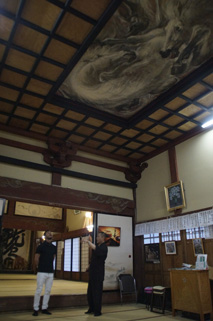
Looking up at the beautiful pictures in the ceiling
One of the characteristics of Churenji is the painting on the ceiling. The ceiling painting on the main pavilion is that of a dragon, titled ”Hiten No Zu (Painting of the Heavenly Flight”, painted by the late Sekisui Ishii. In addition, there are 4 other paintings on the ceiling by modern artists; the painting of hands in prayer, ”Tenku No Tobira (the Door of the Sky)” by Shin Kinoshita ; ”Mizu- No Sei (the Water Spirit ”, a symbolic representation of water as a barrier painted by Atsuyoshi Mitsukubo; ”Seizoku Hyakka Menso (Hundred Faces of the Holy and the Worldly)”: and ”Hakuba Koukan No Zu” by Takayoshi Totoki.
These paintings are by modern artists upon the request for ceiling paintings that will last for a thousand years. The fact that these art were accepted at this temple indicates that there exist a kind of tolerance for people. Churenji, the place of ascetic practices, also exists in unison with people and the mountains.
